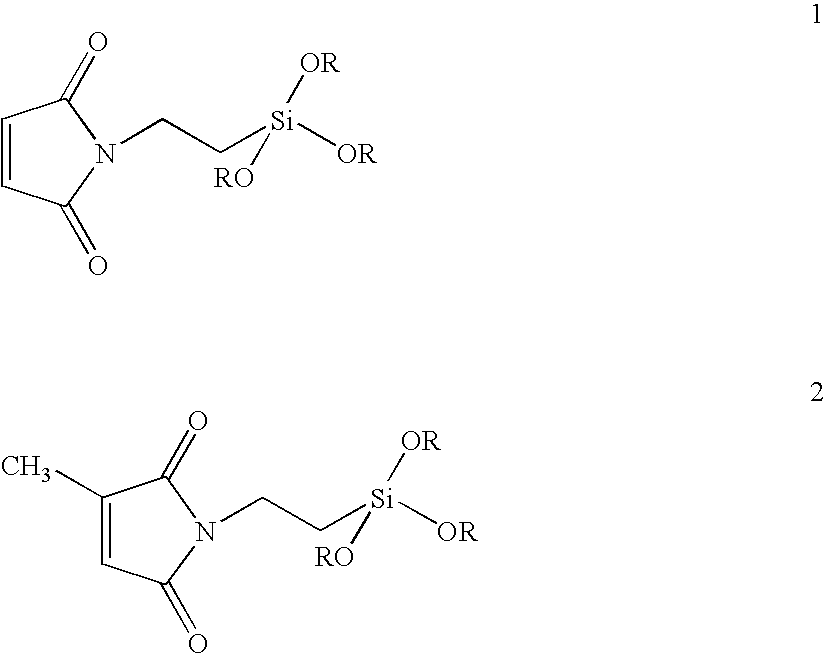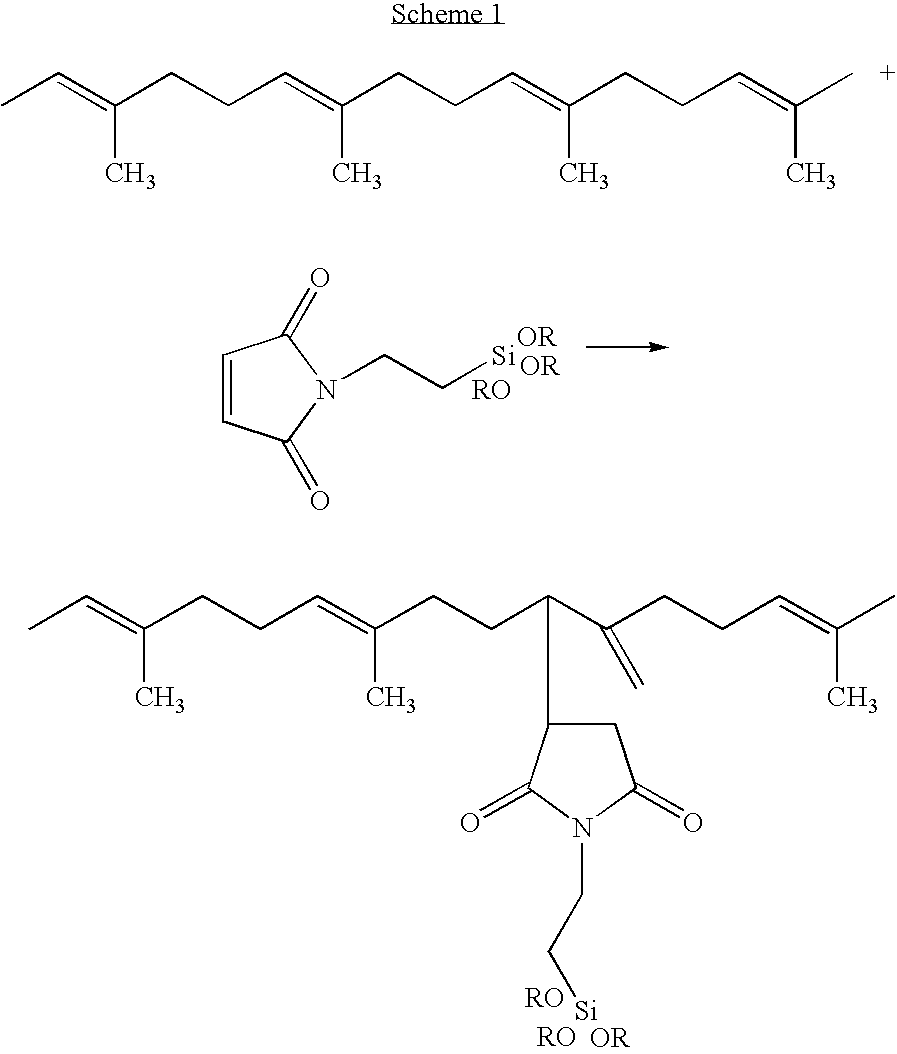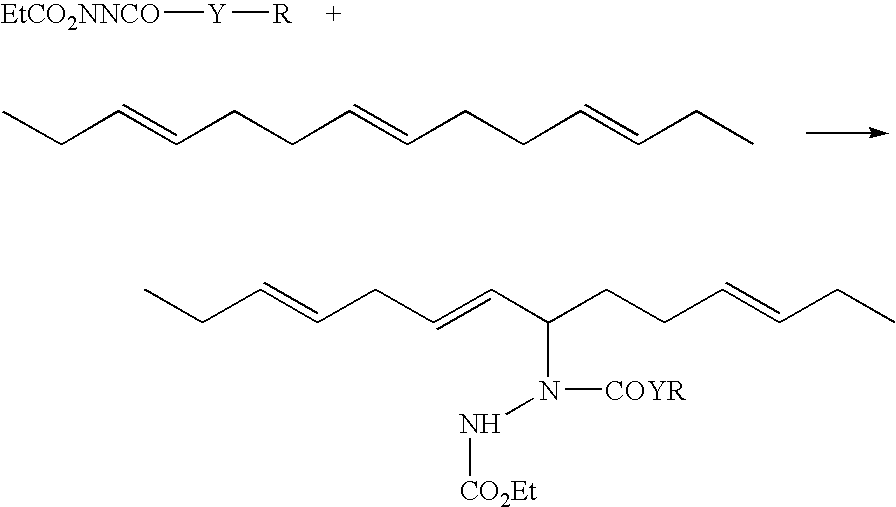Rubber compositions containing non-sulfur silica coupling agents bound to diene rubbers
a technology of diene rubber and composition, which is applied in the field of rubber compositions containing non-sulfur silica coupling agents bound to diene rubber, can solve the problems of poor silica dispersion and high compound viscosity, rigid uncured compound that is difficult to process, and disadvantages of their use, so as to facilitate silica binding, reduce hysteresis and stress/strain properties, and improve the effect of silica dispersion
- Summary
- Abstract
- Description
- Claims
- Application Information
AI Technical Summary
Benefits of technology
Problems solved by technology
Method used
Image
Examples
example 1
Preparation of a Maleimide Triethoxysilane Coupling Agent
[0089]N-(3-propyl triethoxysilyl) maleimide (PSM) is prepared by the addition of 100 mL of a 2.33 molar saturated anhydrous toluene solution of maleic anhydride (22.85 g of anhydride, 0.233 mol) to a one liter flask containing 100 mL of dry toluene and then, under nitrogen, slowly dripping in a solution of 3-aminopropyl triethoxysilane (51.6 g, 54.8 mL, 0.233 mol) dissolved in 100 mL of dry toluene over a 15 minute period. After stirring 2 hours, anhydrous zinc chloride (10 g, 73.3 mmol) and hexamethyldisilazane (HMDS) (47.0 g, 60.7 mL, 0.291 mol) dissolved in 100 mL of dry toluene are added. The solution is heated to 80° C. for 18 hrs with stifling before being filtered and isolated by distillation.
example 2
Preparation of Azo-Bis-Carbonyl Triethoxysilane Coupling Agents
[0090]An N-(3-propyl triethoxysilyl) (NPTS) group can be added to a variety of azo-bis-carbonyl compounds to prepare eneophiles that will readily react with double bonds in a diene rubber.
[0091](A) Reaction of Ethyl Carbazate (EC) with Isocyanates
[0092]To a solution of ethyl carbazate (20.8 g, 0.2 mol) in 200 mL of dry tetrahydrofuran (THF) is added a solution of 3-isocyanatopropyl triethoxysilane (49.5 g, 50 mL, 0.2 mol, available from Gelest) in 50 mL of dry THF. The solvent is removed by heating with vacuum or a nitrogen purge to give an intermediate that is then suspended in 500 mL of dry methylene chloride with anhydrous sodium sulfate (35.5 g, 0.25 mol) added as a drying agent. Into this slurry is slowly bubbled dinitrogen tetroxide until brown vapor of the unreacted gas persists above the solution. Filtration and removal of the solvent allows the isolation of the solid product coupling agent.
[0093](B) Reaction of ...
example 3
Preparation of a Nitrone Coupling Agents By 1,3 Dipolar Addition
[0097]A solution of triethoxysilyl undecanal (66.5 g, 0.2 mol, available from Gelest) in 250 mL of absolute ethanol is added to phenyl hydroxylamine hydrochloride (29.1 g, 0.2 mol) and triethylamine (30.3 g, 41.9 mL, 0.3 mol) and allowed to stand at ambient temperature for 20 hrs. The ethanol and excess amine are removed by heat and vacuum. The desired nitrone product is readily separated from the residue by washing it free of the amine hydrochloride with methylene chloride.
PUM
| Property | Measurement | Unit |
|---|---|---|
| temperature | aaaaa | aaaaa |
| temperature | aaaaa | aaaaa |
| temperature | aaaaa | aaaaa |
Abstract
Description
Claims
Application Information
 Login to View More
Login to View More - R&D
- Intellectual Property
- Life Sciences
- Materials
- Tech Scout
- Unparalleled Data Quality
- Higher Quality Content
- 60% Fewer Hallucinations
Browse by: Latest US Patents, China's latest patents, Technical Efficacy Thesaurus, Application Domain, Technology Topic, Popular Technical Reports.
© 2025 PatSnap. All rights reserved.Legal|Privacy policy|Modern Slavery Act Transparency Statement|Sitemap|About US| Contact US: help@patsnap.com



